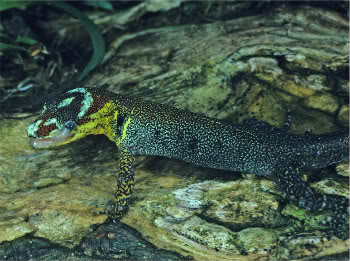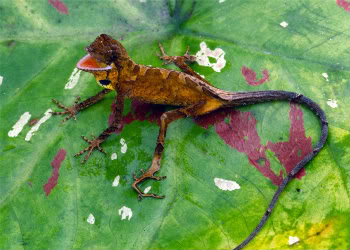|
|
With help from data collected thirty years ago, scientists have discovered that tropical lizards may be particularly sensitive to a warming world. Researchers found that lizards in the tropics are more sensitive to higher temperatures than their relatives in cooler, yet more variable climates.
“The least heat-tolerant lizards in the world are found at the lowest latitudes, in the tropical forests. I find that amazing,” said Raymond Huey, lead author of a paper appearing in the March 4 Proceedings of the Royal Society B.
Huey points out that this sensitivity to heat is due to the fact that since tropical forests have narrow temperature ranges, tropical lizards have evolved so that they are nearly always performing at or near peak levels. While studying lizards in Puerto Rico in the 1970s, Huey recorded that native lizards were performing at 90 percent of their ability even during the coldest and warmest parts of the day. Such adaptation has served them well in the past, but it makes them very vulnerable to extreme temperatures.
 Gonatodes humeralis is a small gecko that lives on tree trunks in the tropics. Photo by Dr. Laurie Vitt. |
“In the 1970s a bunch of us were running around the Caribbean with thermometers taking lizard body temperatures for reasons totally unrelated to climate warming. But we can use our data from a third a century ago as a baseline to now predict how lizards at different latitudes would respond to climate change,” Huey said.
As an example, Huey points to the yellow-chinned anole, anolis gundlachi and the Puerto Rican crested anole snolis cristatellus. The yellow-chinned anole is adapted to the shade of the Puerto Rican rainforest, while the crested anole prefers warmer open regions. Since his initial study in the 1970s, Huey point out that the forests average temperature has risen from 80 degrees Fahrenheit to almost 83.5 degrees.
“That may not sound like much, but we think gundlachi is going to get hammered because it will suffer heat stress from the warmer temperatures,” Huey said.
In addition, with predictions that the tropics could warm another 5 degrees Farenheit in less than a century, the forest could soon become warm enough for the crested anole to invade the yellow chinned’s territory, adding new competition for limited resources.
 The Anolis nitens lives in the leaf litter in the tropics. Photo by Dr. Laurie Vitt. |
Tropical lizards like the yellow-chinned anole may be able to adapt to a warmer environment, but Huey remains skeptical: “we don’t think it’s likely because of their long generation times.”
If warmer temperatures lead to changes in the forest structure, such as a more open canopy and therefore increased sunlight, rainforest lizards may find that their ecosystem has changed faster than they can keep up.
“Because tropical forest lizards aren’t very heat tolerant and they live in environments that are already warm, any further warming could push them over the edge,” Huey concludes.
Related articles
Bad news for frogs; amphibian decline worse than feared,
Global warming, not disease, may be the culprit this time
(04/16/2007) Chilling new evidence suggests amphibians may be in worse shape than previously thought due to climate change. Further, the findings indicate that the 70 percent decline in amphibians over the past 35 years may have been exceeded by a sharp fall in reptile populations, even in otherwise pristine Costa Rican habitats. Ominously, the new research warns that protected areas strategies for biodiversity conservation will not be enough to stave off extinction. Frogs and their relatives are in big trouble.
Legless lizard retracts eyes to avoid retaliatory prey bites
(08/14/2007)
For creatures without legs, snakes are remarkable predators. Pythons can capture and eat animals well over twice their size, while a mere drop of venom injected by an Australian death adder can kill a person. Scientists believe the main purpose for these adaptations is to help snakes avoid injury when pursuing and eating prey.
New snake-like lizard discovered in India
(05/28/2007)
A previously unknown species of legless lizard as been discovered in a remote Indian forest, reports the Associated Press.
One of world’s only pure blue lizard at risk of extinction
(03/07/2007)
High above the forest floor on the remote Colombian island of Gorgona lives a lizard with brilliant blue skin, rivaling the color of the sky. Anolis gorgonae, or the blue anole, is a species so elusive and rare, that scientists have been unable to give even an estimate of its population. Due to the lizard’s isolated habitat and reclusive habits, researchers know little about the blue anole, but are captivated by its stunning coloration.